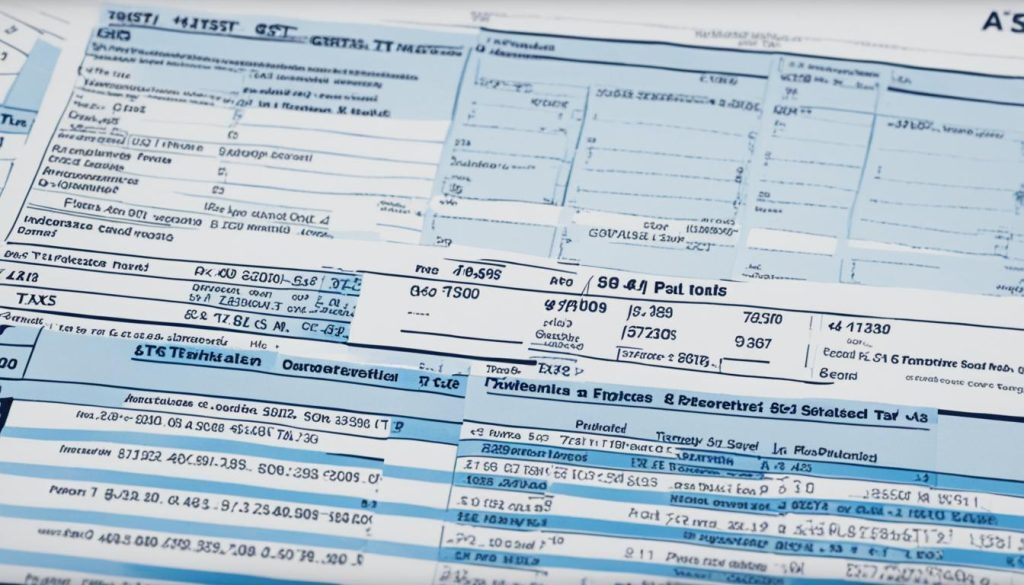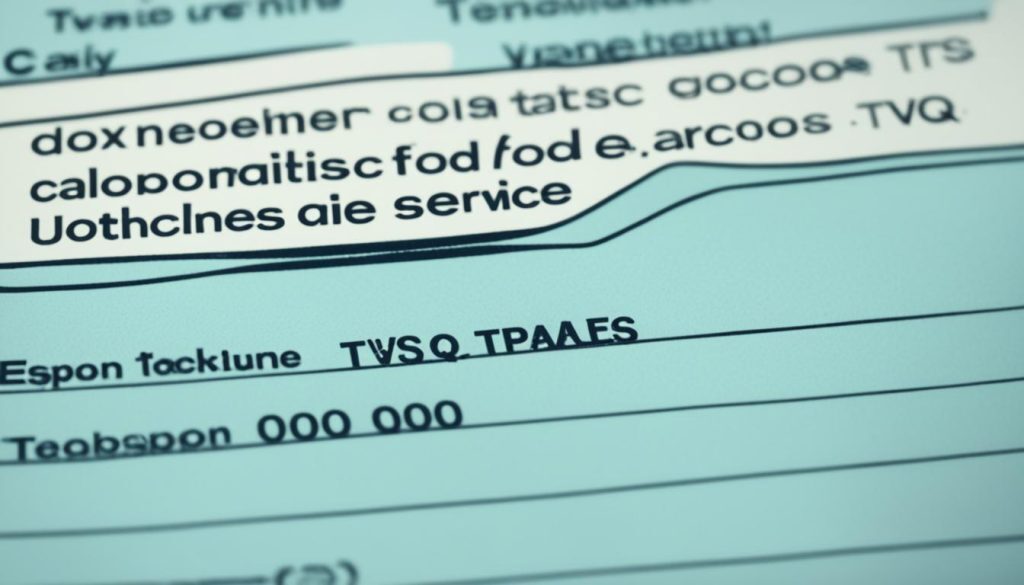As a Canadian small-business owner, it is crucial to have a solid understanding of the different types of sales tax in Canada. This includes the Goods and Services Tax (GST), Provincial Sales Tax (PST), and Quebec Sales Tax (QST/TVQ). Managing these taxes accurately is essential for tax collection and compliance.
Key Takeaways:
- Goods and Services Tax (GST) is a federal tax managed by the Canada Revenue Agency and applies a 5% charge to most goods and services in Canada.
- Provincial Sales Tax (PST) is a retail sales tax imposed by provincial governments and its application varies by region.
- Quebec Sales Tax (QST/TVQ) applies to businesses in Quebec and is collected in addition to the GST. The QST rate is 9.975%.
- Understanding the tax rates and knowing how to calculate TPS and TVQ is vital for accurate tax collection and compliance.
- Small businesses can use the Canadian tax calculator provided by the Canada Revenue Agency to simplify tax calculations and ensure accurate financial planning.
GST, PST, and HST Explained
Understanding the different types of sales tax in Canada is crucial for small-business owners. Let’s dive into the details of Goods and Services Tax (GST), Provincial Sales Tax (PST), and Harmonized Sales Tax (HST) to clarify their significance and how they affect your business.
Goods and Services Tax (GST)
The Goods and Services Tax (GST) is a federal tax managed by the Canada Revenue Agency. It applies to almost all goods and services in Canada, with a standard rate of 5%. This tax is added to the selling price of goods or services and is collected by the business owner.
Provincial Sales Tax (PST)
Provincial Sales Tax (PST) is a tax imposed by provincial governments in Canada. The application and rates of PST vary depending on the province. For example, in British Columbia, the PST rate is 7%. It is essential for small-business owners to understand the specific regulations and requirements for collecting PST in their respective provinces.
Harmonized Sales Tax (HST)
The Harmonized Sales Tax (HST) combines the GST and PST into one tax in certain provinces. For instance, in Newfoundland and Labrador, the HST rate is 15%, with the federal portion being 5% (GST) and the provincial portion being 10% (PST). Participating provinces include Newfoundland and Labrador, Nova Scotia, New Brunswick, Prince Edward Island, and Ontario.
Businesses located in these provinces charge the HST instead of separate GST and PST. This simplifies the tax collection process for both businesses and consumers.

Quebec Sales Tax (QST)
In Quebec, businesses are required to charge the Quebec Sales Tax (QST), also known as the Taxe de vente du Québec (TVQ), in addition to the GST. The QST rate is 9.975%. The QST is collected by the business owner and remitted to Revenu Quebec.
Quebec Sales Tax Calculation
To calculate the total sales tax on a purchase in Quebec, you can add the QST and GST percentages to the purchase price. For example, if the purchase price is $100, the total amount after adding the QST (9.975%) and GST (5%) would be $114.975.
| Tax | Rate |
|---|---|
| GST | 5% |
| QST (TVQ) | 9.975% |
Taxable Goods and Services
When it comes to taxes, it’s important for small-business owners to know which goods and services are considered taxable. Understanding what falls under the taxable category can help ensure accurate tax collection and compliance. Let’s explore some examples of taxable goods and services:
- Universities: Tuition fees charged by universities are subject to taxes.
- Tour operators and packages: If you offer tour packages or operate a tour company, the services you provide are taxable.
- Telecommunication channels: Services related to telecommunication, such as phone lines and internet connections, are taxable.
- Tribal councils: Goods and services provided by tribal councils are taxable.
It’s important to note that while these items are taxable, there are also zero-rated goods and services that still carry a tax charge of 0%. Some examples of zero-rated items include medical devices, groceries, livestock and fishery products, and exports.
Additionally, certain products are exempt from tax altogether. This means that the purchase of these goods or services is not subject to any tax charges. Examples of exempt items include health, medical, dental, educational, and legal services.
As a small-business owner, it’s beneficial to know which goods and services fall into each category. It allows you to accurately apply the applicable tax rates, adjust pricing accordingly, and confidently navigate the tax landscape.
| Tax Category | Examples | Applicable Tax Rate |
|---|---|---|
| Taxable Goods and Services | Universities | 5% GST + applicable provincial taxes |
| Tour operators and packages | 5% GST + applicable provincial taxes | |
| Telecommunication channels | 5% GST + applicable provincial taxes | |
| Tribal councils | 5% GST + applicable provincial taxes | |
| Zero-Rated Items | Medical devices | No additional tax charge, but still taxable |
| Groceries | No additional tax charge, but still taxable | |
| Livestock and fishery products | No additional tax charge, but still taxable | |
| Exports | No additional tax charge, but still taxable | |
| Exempt Items | Health, medical, dental, educational, and legal services | No tax charge |
Small-business owners can also benefit from claiming input tax credits on zero-rated items. This allows them to recover the GST or HST paid on expenses or purchases related to their company, ultimately reducing their overall tax liability. Understanding the tax categories and rates is key to managing your business finances efficiently and ensuring compliance with tax regulations.

Registering for Taxes
As a small business owner in Canada, it is important to understand the process of registering for taxes. Registering ensures that your business complies with the necessary regulations and can collect and remit taxes appropriately. Here’s an overview of how to register for taxes in 2020:
- Step 1: Determine if you need to register with the Canada Revenue Agency (CRA) for a GST/HST account. If your business is considered a small supplier and your revenue is less than $30,000 in the last four consecutive calendar quarters, you are not required to collect Goods and Services Tax (GST) or Harmonized Sales Tax (HST). However, if your revenue exceeds the $30,000 threshold, you must register for a GST/HST account with the CRA.
- Step 2: Visit the Canada Revenue Agency’s website and navigate to the registration section. You can register online through the Business Registration Online (BRO) service. Make sure to have all the necessary information and documentation on hand, such as your business number, legal name, and contact information.
- Step 3: Complete the registration process by providing the required details and following the instructions provided. Once your registration is complete, you will receive your GST/HST account number, which you will use for tax purposes.
- Step 4: For small businesses operating in Quebec, it is also necessary to register with Revenu Quebec to file taxes and collect returns. Visit Revenu Quebec’s website to register and follow the instructions provided. Ensure you have all the necessary information and documentation ready for the registration process.
By registering for taxes, you ensure that your small business is compliant with the tax regulations in Canada and Quebec. This allows you to collect and remit the appropriate taxes, avoiding any penalties or legal issues. Make sure to keep your GST/HST account number and any relevant documentation handy for future tax filings.
Example Table: Small Business Tax Registration Checklist
| Task | Description |
|---|---|
| Check eligibility | Determine if your business exceeds the small supplier threshold and needs to register for a GST/HST account. |
| Gather documentation | Collect all necessary information, such as your business number, legal name, and contact details. |
| Visit CRA website | Go to the Canada Revenue Agency’s website and navigate to the registration section. |
| Complete online registration | Use the Business Registration Online (BRO) service to register for a GST/HST account. |
| Register with Revenu Quebec | If operating in Quebec, visit Revenu Quebec’s website and follow their registration process. |
| Receive account number | Once registered, you will receive your GST/HST account number and any other relevant documents. |
Quebec Sales Tax (QST) Calculation
In Quebec, as a small-business owner, it is essential to understand how to calculate the Quebec Sales Tax (QST) on goods and services sold within the province. This calculation is crucial for accurate tax collection and compliance with provincial tax laws.
The QST rate in Quebec is 9.975%, which is applied in addition to the 5% Goods and Services Tax (GST). To calculate the total sales tax, simply add the QST and GST percentages to the purchase price. For example, if a customer purchases an item worth $100 in Quebec, the total amount including sales tax would be $114.975 after adding the QST (9.975%) and GST (5%).
To ensure compliance with provincial tax laws, it is important to register with Revenu Quebec and collect and remit the appropriate tax amounts. By correctly calculating and charging the QST, small-business owners can simplify financial planning and ensure accurate accounting for tax obligations.
For assistance in determining the exact amount of QST and GST to charge your customers, you can use a Canadian tax calculator provided by the Canada Revenue Agency. This calculator takes into account the latest federal and provincial tax rates, ensuring accurate tax calculations and helping you stay compliant with tax regulations.
Using a Canadian Tax Calculator
As a small-business owner in Canada, calculating taxes can be a complex and time-consuming task. However, with the help of a Canadian tax calculator, you can simplify the process and ensure accurate tax calculations.
The Canada Revenue Agency offers a reliable tax calculator that takes into account the latest federal and provincial tax rates. With this calculator, you can easily determine the tax payable on your sales by inputting the sales price. The calculator will automatically add the applicable tax rates, including the Goods and Services Tax (GST), Provincial Sales Tax (PST), and Quebec Sales Tax (QST), providing you with an accurate tax amount that needs to be collected from your customers.
This tax calculator not only saves you time but also helps with financial planning and compliance. By knowing the exact tax amount to be collected, you can better manage your finances and ensure that you are in line with the tax regulations. Moreover, the calculator can also be used to determine the pre-tax amount by subtracting the sales tax from the total price, giving you a clear understanding of the actual cost of the product or service.
Whether you need to calculate TPS and TVQ or the Quebec Sales Tax, using a Canadian tax calculator is a smart choice for small-business owners. It provides convenience, accuracy, and peace of mind, allowing you to focus on growing your business and serving your customers. Take advantage of this helpful tool provided by the Canada Revenue Agency and simplify your tax calculations today.